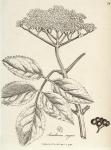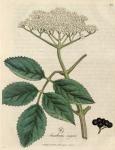
 Synonyma. Sambucus. Pharm. Lond. & Edinb.
Sambucus fructu in umbella nigro. Bauh. Pin. p. 456.
Synonyma. Sambucus. Pharm. Lond. & Edinb.
Sambucus fructu in umbella nigro. Bauh. Pin. p. 456.
Sambucus vulgaris. Park. Theat. p. 407. J. Bauh. vol. i. p. 544. Raii. Hist. p. 1609. Synop. p. 461. Gerard. Emac. p. 1422. Hudson Flor. Ang. p.
130. Flor. Dan. 545. Withering. Bot. Arrang. p. 320. Duhamel, t. 65.
Sambucus arborea, floribus umbellatis. Hal. Stirp. Helv. n. 670.
Varietates sunt,
β Sambucus fructu in umbella viridi. C. Bauh.
γ Sambucus laciniato folio. C. Bauh.
Class Pentandria. Ord. Trigynia. Lin. Gen. Plant. 372.
Ess. Gen. Ch. Cal. 5-partitus. Cor. 5-fida. Bacca 3-sperma.
Spec. Char. S. cymis quinquepartitis, foliis pinnatis, caule arboreo.
The root is woody, from which issues a shrubby stem often to the height of twelve or sixteen feet: it is much branched towards the top, and covered with a rough whitish bark: the wood is hard, tough, and contains in the centre a large proportion of medullary matter, or pith: the leaves are pinnated, consisting of two or three pair of pinnae or leafits, with an odd one at the end; they are oval, veined, smooth, deeply serrated, and of a deep green colour: the flowers are small, white, and produced in large flat umbels or clusters: the calyx is permanent, placed above the germen, and divided into five segments: the corolla is monopetalous, wheel-shaped, somewhat convex, and divided into five obtuse segments: the filaments are tapering, spreading, equal in length to the corolla, and crowned with roundish antherae: the germen is oval, and furnished with a prominent gland, which supplies the place of the styles, and supports three blunt stigmata: the fruit is a round succulent berry, of a blackish purple colour, and contains three seeds, which are flat on one side, and angular on the other. It is a native of Britain, in moist hedges and woods, and flowers in May and June.
This species is the (greek) [Sambucus, (greek) Graecis, a Sambuca musico instrumento, quod alii pectida, alii magadin vocant, dicta putatur. Alii ab autore cui nomen Sambyx denominatam malunt. Nobis vox incertae originis esse videtur. Raii Hist. p. 1609.] of the Greek writers, and has been long very generally employed for medical purposes. The whole plant has an unpleasant narcotic smell, and some authors have reported its exhalations to be so noxious as to render it unsafe to sleep under its shade. [The Berries are said to be poisonous to poultry. (Barthol. Hist. anat. rarior. Cent. iv. p. 248.) And the flowers to peacocks. Linn. Flor. Suec. p. 79. If turneps, cabbages, fruit-trees, or corn, (which are subject to blight from a variety of insects) are whipped with the green leaves and branches of Elder, the insects will not attack them. Withering l. c. See Phil. Trans. vol. lxii. p. 348.] The parts of the Sambucus, which are proposed for medicinal use in the Pharmacopoeias, [The leaves are purgative like the bark, but more nauseous.] are the inner bark, the flowers, and the berries. The first has scarcely any smell, and very little taste: on first chewing, it impresses a degree of sweetishness, which is followed by a very slight, but durable, acrimony, in which its powers seem to reside, and which it imparts both to watery and spirituous menstrua. It is strongly cathartic, and on this account was much used by Sydenham [Oper. p. 496.] and Boerhaave, [Hist. Plant. P. I. p. 207,] who recommend it as an effectual hydragogue; the former directs three handfuls of it to be boiled in a quart of milk and water, till only a pint remains, of which one half is to be taken night and morning, and repeated for several days: it usually operates both upwards and downwards, and upon the evacuations it produces, its utility depends. Boerhaave gave its expressed juice in doses from a dram to half an ounce. In smaller doses it is said to be an useful aperient and deobstruent in various chronical disorders.
"The flowers have an agreeable flavour, which they give over in distillation with water, and impart by infusion both to water and rectified spirit: on distilling a large quantity of them with water, a small portion of a butyraceous essential oil separates. Infusions made from the fresh flowers are gently laxative and aperient: when dry they are said to promote chiefly the cuticular excretion, and to be particularly serviceable in erysipelatous and eruptive disorders." Externally they arc used in fomentations, &c. and in the London Pharmacopoeia directed in the form of an ointment. "The berries, in taste, are somewhat sweetish, and not unpleasant; on expression, they yield a fine purple juice, which proves an useful aperient and resolvent in recent colds and sundry chronical diseases, gently loosening the belly, and promoting urine and perspiration." [Lewis M. M. p. 576.] The officinal preparation of these berries is the succus baccae sambuci spissatus. (Pharm. Lond.)

